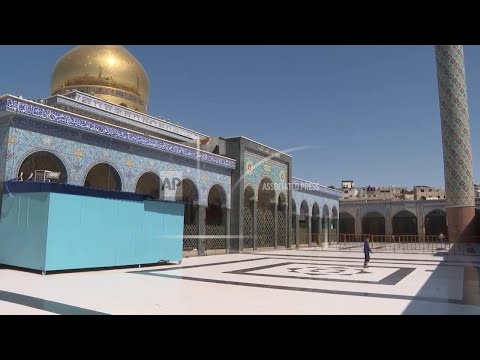(21 May 2025)
RESTRICTION SUMMARY:
ASSOCIATED PRESS
Sayyida Zeinab, Damascus, Syria – 15 March 2025
1. Wide of Sayyida Zeinab shrine
2. Various of worshippers at shrine
3. SOUNDBITE (Arabic) Jaaffar Kassem, Sayyida Zeinab shrine director:
"In that period of fear that people had in the first day or the first two days, perhaps, after the fall of the regime, many people from across society, employees, people from the Shiite community, people from outside the Shiite community had left Damascus to go to Lebanon or Iraq or anywhere they could go. But after a few days, a lot of these people came back. And within weeks, the majority had come back.”
4. Tilt-down of shrine
5. Various of interiors of shrine, worshippers inside praying and reading Quran
6. Worshipper crying at shrine
7. SOUNDBITE (Arabic) Ahmad Majzoub, Iraqi Shiite visitor:
"Our cause is about Sayyida Zeinab. She matters to us. All the rest of these matters are internal issues. I cannot involve myself in a place or spread fear among people. Besides, we have brothers there, the Shiites there are followers of the doctrine of the family (of the Prophet Muhammad). They are our brothers and the brothers of the rest of the Syrians. We are brothers, united from ancient times, from a long time ago. And we are here now and will be in the future as brothers who cannot be separated by someone being Shiite, or Sunni or Christian. No."
8. Worshippers at shrine
9. Tilt-down of interior of shrine
STORYLINE:
At the Sayyida Zeinab shrine, rituals of faith unfold: worshippers kneel in prayer; visitors raise their palms skyward or fervently murmur invocations as they press their faces against an ornate enclosure surrounding where they believe the granddaughter of Prophet Muhammad is entombed.
But it’s more than just religious devotion that the golden-domed shrine became known for during Syria’s prolonged civil war.
At the time, protecting shrines from Sunni extremists became a rallying cry for some Shiite fighters and Iran-backed groups from beyond Syria’s borders who backed the former government of Bashar Assad.
The shrine and its suburb, which bears the same name, thus, emerged as one symbol of how the religious and geopolitical intertwined during the conflict.
With such a legacy in the backdrop, local Shiite community leaders and members are now navigating a dramatically altered political landscape around Sayyida Zeinab, and beyond, after Assad’s December ouster by armed insurgents led by the Sunni Islamist group Hayat Tahrir al-Sham (HTS).
The complex transition that is underway has left some in Syria’s small Shiite minority feeling vulnerable.
There was a "period of fear that people had in the first day or the first two days, perhaps, after the fall of the regime," said shrine director Jaaffar Kassem.
Zeinab is the daughter of the first Shiite Imam, Ali, cousin and son-in-law of Prophet Muhammad.
She has earned several titles, such as the "mother of misfortunes" for enduring tragedies, including the 7th-century killing of her brother, Hussein.
His death exacerbated the schism between Islam’s two main sects, Sunni and Shiite, and is mourned annually by Shiites.
Zeinab’s burial place is disputed; some Muslims believe it’s elsewhere.
The Syria shrine has drawn pilgrims, including from Iran, Iraq and Lebanon. Since Assad’s ouster, however, fewer foreign visitors have come, an economic blow to those catering to them in the area.
Over the years, the Sayyida Zeinab suburb has suffered deadly attacks by militants.
Post Assad, some tensions have centred on the shrine.
Find out more about AP Archive: http://www.aparchive.com/HowWeWork
Twitter: https://twitter.com/AP_Archive
Facebook: https://www.facebook.com/APArchives
Instagram: https://www.instagram.com/APNews/
You can license this story through AP Archive: http://www.aparchive.com/metadata/youtube/90a35dac66e84235937b7e64c0c11d86
Author: AP Archive
Go to Source
News post in May 26, 2025, 6:06 pm.
Visit Our Sponsor’s:
News Post In – News





